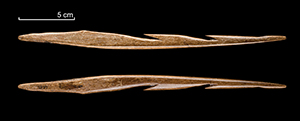Crossref Citations
This article has been cited by the following publications. This list is generated based on data provided by
Crossref.
Kozowyk, Paul R.B.
and
Poulis, Johannes A.
2019.
A new experimental methodology for assessing adhesive properties shows that Neandertals used the most suitable material available.
Journal of Human Evolution,
Vol. 137,
Issue. ,
p.
102664.
Degano, Ilaria
Soriano, Sylvain
Villa, Paola
Pollarolo, Luca
Lucejko, Jeannette J.
Jacobs, Zenobia
Douka, Katerina
Vitagliano, Silvana
Tozzi, Carlo
and
Zerboni, Andrea
2019.
Hafting of Middle Paleolithic tools in Latium (central Italy): New data from Fossellone and Sant’Agostino caves.
PLOS ONE,
Vol. 14,
Issue. 6,
p.
e0213473.
Devièse, Thibaut
Veall, Margaret-Ashley
Allen, Richard
Riesmeier, Marabel
Cameron, Jamie
Bonjean, Dominique
and
Higham, Thomas
2020.
From photogrammetry to radiocarbon dating; investigating hafting adhesives on stone tools using a multi-analytical approach.
Journal of Archaeological Science: Reports,
Vol. 34,
Issue. ,
p.
102664.
Kozowyk, Paul R. B.
van Gijn, Annelou L.
and
Langejans, Geeske H. J.
2020.
Understanding preservation and identification biases of ancient adhesives through experimentation.
Archaeological and Anthropological Sciences,
Vol. 12,
Issue. 9,
Smith, Geoff M.
Noack, Elisabeth S.
Behrens, Nina Maria
Ruebens, Karen
Street, Martin
Iovita, Radu
and
Gaudzinski-Windheuser, Sabine
2020.
When Lithics Hit Bones: Evaluating the Potential of a Multifaceted Experimental Protocol to Illuminate Middle Palaeolithic Weapon Technology.
Journal of Paleolithic Archaeology,
Vol. 3,
Issue. 2,
p.
126.
Topal, Erkan
Ceylan, Özgür
Kösoğlu, Mustafa
Mărgăoan, Rodica
and
Cıpcıgan, Mihaiela Cornea
2020.
BAL MUMUNUN YAPISI, KULLANIM ALANLARI ve BAZI TEMEL SORUNLARI.
Uludağ Arıcılık Dergisi,
Vol. 20,
Issue. 2,
p.
209.
Whelton, Helen L.
Hammann, Simon
Cramp, Lucy J.E.
Dunne, Julie
Roffet-Salque, Mélanie
and
Evershed, Richard P.
2021.
A call for caution in the analysis of lipids and other small biomolecules from archaeological contexts.
Journal of Archaeological Science,
Vol. 132,
Issue. ,
p.
105397.
Tafelmaier, Yvonne
Bataille, Guido
Schmid, Viola
Taller, Andreas
and
Will, Manuel
2022.
Methods for the Analysis of Stone Artefacts.
p.
57.
Gundev, Promita
Chauhan, Komal
Sachdev, Divya
and
Swer, Tanya Luva
2022.
Formulation and characterization of butylated hydroxytoluene (BHT) microspheres using natural beeswax as encapsulating material.
Journal of Food Processing and Preservation,
Vol. 46,
Issue. 4,
Taipale, Noora
Cnuts, Dries
Chiotti, Laurent
Conard, Nicholas J.
and
Rots, Veerle
2022.
What about Apatite? Possibilities and Limitations of Recognising Bone Mineral Residues on Stone Tools.
Journal of Paleolithic Archaeology,
Vol. 6,
Issue. 1,
Michel, Marine
and
Rots, Veerle
2022.
Into the light: The effect of UV light on flint tool surfaces, residues and adhesives.
Journal of Archaeological Science: Reports,
Vol. 43,
Issue. ,
p.
103479.
Pfeifer, Sebastian J.
2022.
Old design – New material.
Journal of Archaeological Science: Reports,
Vol. 46,
Issue. ,
p.
103688.
Pétillon, Jean-Marc
2023.
Préhistoire. Nouvelles frontières.
p.
185.
Javier Muñoz, Francisco
Rubio, Verónica
Gutiérrez, Carmen
Hernanz, Antonio
and
Menéndez, Mario
2023.
THE POINTS FROM EL BUXU CAVE (ASTURIAS, SPAIN): First evidence of adhesive as hafting material in the Solutrean.
Journal of Archaeological Science: Reports,
Vol. 49,
Issue. ,
p.
103901.
Tsirintoulaki, Kalliroi
Matzig, David Nicolas
and
Riede, Felix
2023.
A 2D Geometric Morphometric Assessment of Chrono-Cultural Trends in Osseous Barbed Points of the European Final Palaeolithic and Early Mesolithic.
Open Archaeology,
Vol. 9,
Issue. 1,
Mărgărit, Monica
Anghelinu, Mircea
Händel, Marc
and
Cordoș, Cristina
2023.
A world of reindeer: A technological and functional reassessment of the Last Glacial Maximum osseous industry from Cotu Miculinți (northeastern Romania).
Journal of Archaeological Science: Reports,
Vol. 51,
Issue. ,
p.
104153.
Buckley, Stephen
Hardy, Karen
Hallgren, Fredrik
Kubiak-Martens, Lucy
Miliauskienė, Žydrūnė
Sheridan, Alison
Sobkowiak-Tabaka, Iwona
and
Subirà, Maria Eulalia
2023.
Human consumption of seaweed and freshwater aquatic plants in ancient Europe.
Nature Communications,
Vol. 14,
Issue. 1,
Koch, Tabea J.
Saurel, Marion
Bocquillon, Hervé
Pisani, Didier F.
Bonnabel, Lola
Little, Aimée
Stacey, Rebecca
Rageot, Maxime
Regert, Martine
and
Cerasoni, Jacopo Niccolò
2024.
Differences in birch tar composition are explained by adhesive function in the central European Iron Age.
PLOS ONE,
Vol. 19,
Issue. 4,
p.
e0301103.
Cnuts, Dries
Rots, Veerle
and
Peresani, Marco
2024.
Examining the effect of post-depositional processes on the preservation and identification of stone tool residues from temperate environments: An experimental approach.
PLOS ONE,
Vol. 19,
Issue. 10,
p.
e0309060.
Bea, Manuel
Roman, Dídac
and
Domingo, Inés
2024.
Hanging over the Void. Uses of Long Ropes and Climbing Rope Ladders in Prehistory as Illustrated in Levantine Rock Art.
Cambridge Archaeological Journal,
Vol. 34,
Issue. 1,
p.
127.
